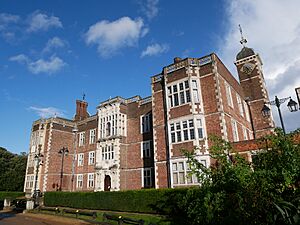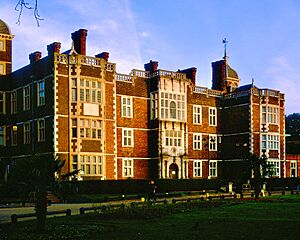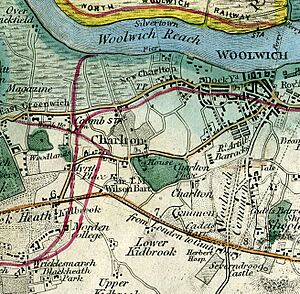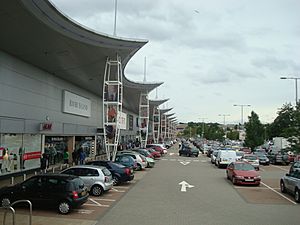Charlton, London facts for kids
Quick facts for kids Charlton |
|
|---|---|
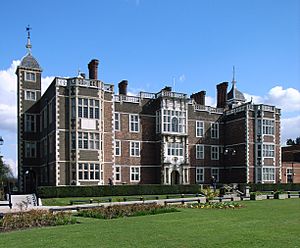 Charlton House |
|
| Population | 14,385 (2011 census for Charlton ward) |
| OS grid reference | TQ415785 |
| • Charing Cross | 7.2 mi (11.6 km) WNW |
| London borough | |
| Ceremonial county | Greater London |
| Region | |
| Country | England |
| Sovereign state | United Kingdom |
| Post town | LONDON |
| Postcode district | SE7 |
| Dialling code | 020 |
| Police | Metropolitan |
| Fire | London |
| Ambulance | London |
| EU Parliament | London |
| UK Parliament |
|
| London Assembly |
|
Charlton is a cool area in southeast London, England. It's part of the Royal Borough of Greenwich. You can find it east of Greenwich and west of Woolwich. It sits right on the south bank of the River Thames. Charlton is about 7.2 miles (11.6 km) southeast of Charing Cross.
Long ago, Charlton was a small parish in Kent. In 1855, it became part of London. Today, it's famous for being home to Charlton Athletic F.C., a football club. It also has the historic Charlton House.
Contents
History
What's in a Name?
Charlton's name comes from old English words. In the 1086 Domesday Book, it was called Cerletone. This name means 'farmstead of the freemen or peasants'. It's a common name in England. For a while, it was called Charlton next Woolwich. This helped tell it apart from another Charlton near Dover. Later, the area near the river became known as New Charlton.
Medieval Times
In 1086, Charlton was owned by Gundulf, bishop of Rochester. Before that, two brothers, Godwine and Alweard, held it. A church dedicated to St Luke was in the village by 1077. Sadly, none of the old medieval church building is left today.
In 1093, the land of Charlton was given to Bermondsey Abbey. This was a special gift from Bishop Robert Bloet. In 1268, the Abbey got permission for a market. This market was held every Monday in Charlton. They also had a three-day fair each year. This fair happened around Trinity Sunday.
The Renaissance Era
Between 1607 and 1612, a new manor house was built. This house was Charlton House. It was built by Sir Adam Newton. He was a teacher to Prince Henry. Prince Henry was the oldest son of King James I. The house was designed in the Jacobean style by John Thorpe. But Prince Henry never used it, as he passed away in 1612.
In the garden of Charlton House, there's a mulberry tree. It was planted in 1608 by order of King James. He hoped to grow silkworms there. After Sir Adam Newton died, St Luke's Church was rebuilt.
Later History
Later, the land was owned by Sir William Langhorne, 1st Baronet. He was a colonial administrator. He is buried in the local church. When he died in 1715, his land went to the Conyers baronets. Then it passed to the Maryon-Wilson baronets.
In the early 1700s, Charlton had a famous fair. It was called The Horn Fair. This fair was held every year on October 18. It was known for being a bit wild and lively. In 1872, the fair was stopped by the government.
In the early 1800s, Spencer Perceval was buried at St Luke's church. He was the only British Prime Minister to be assassinated. His wife was from the Maryon-Wilson family.
Growing with Industry
The flat land near the Thames became a big industrial area. This started in Victorian times. Many factories and businesses grew around Charlton Pier. This led to some big fires in the mid-1800s.
One important factory was Siemens Brothers Telegraph Works. It opened in 1863. They made two new transatlantic cables in the 1880s. They also helped with Operation Pluto in World War 2. This was a secret project.
It was in this industrial area that Charlton Athletic F.C. started in 1905. They moved to their stadium, The Valley, in 1919.
The 20th Century
From 1903 to 1913, an Italian writer lived in Charlton. His name was Italo Svevo. You can see a blue plaque on his old house. He worked for a company that sold special paint for ships. He set up a factory in Charlton to fulfill a big order for the British Royal Navy.
A metal foundry called J. Stone & Co moved to Charlton in 1917. During World War II, they made 22,000 propellers for the Royal Navy. These propellers were used on battleships and aircraft carriers. They also made parts for famous ships like the RMS Queen Mary and RMS Queen Elizabeth. Stone Foundries still works in Charlton today. They make metal parts for the aircraft industry.
The large estates around Charlton House were slowly divided up. When the Maryon-Wilson family ended in 1925, the open spaces became public parks. Two of these parks are named after the family. Charlton House itself became a public building. It is now a library and community center. Maryon Park was even used for filming a scene in the movie Blow-Up (1966).
Geography

Charlton Village is the main part of Charlton. It sits on high ground about 7 miles east-south-east of central London. A preserved old red K2 telephone box stands on Charlton Road. A smaller road, Charlton Church Lane, goes down to the station.
Beyond the railway line is the industrial area. This part is called New Charlton or Charlton Riverside.
Charlton has several parks. These include Maryon Park, Maryon Wilson Park, and Hornfair Park. Charlton Park has many sports fields. Next to Maryon Park is Gilbert's Pit. This area used to be a big sand quarry. Most of the parks are in an area that was once a forest called Hanging Wood.
The buildings in Charlton show its history. You can see how it changed from a village to a London suburb. Charlton House is a famous building here. A street is named after the architect Inigo Jones. Other streets are named after important people or places. These include Montcalm, Henry, Prince of Wales, Canberra, and Kashmir.
There are four main pubs near Charlton Village. One is The Bugle Horn, an old coaching inn. A big landmark is The Valley stadium. It's the home of Charlton Athletic F.C..
New Charlton is where you'll find the southern end of the Thames Barrier. This barrier protects London from floods. It has a visitor center too. In 2013, a special school opened nearby. It's now called Royal Greenwich Trust School.
Nearby areas include Blackheath, Eltham, Greenwich, Kidbrooke, Maze Hill, North Greenwich, Plumstead, Welling, and Woolwich.
 |
 |
|||
People of Charlton
In 2011, the population of Charlton was 14,385 people. About half of the people were White British. Other large groups included Black African and White (Other). Most people spoke English as their first language. The next most common language was Nepalese.
Almost half of the people were Christians. About a third said they had no religion. The next largest religious group was Muslims.
Many households in Charlton had no adults working. Of those who did work, many were in retail, education, or healthcare. A good number of people worked in professional jobs. About 43% of the people in Charlton were between 20 and 44 years old.
Economy
Charlton Village still has some traditional shops. But a much bigger shopping area is in New Charlton. This area has the Greenwich Shopping Park, the Peninsula Retail Park, and Stone Lake Retail Park. A large Sainsbury's supermarket opened in 2015.
Sainsbury's also has a big distribution center in New Charlton. It was rebuilt in 2012. The Deputy Prime Minister, Nick Clegg, reopened it in 2013.
New Charlton is also where heavy industry still exists. In the 1800s, there was a large rope factory and other businesses related to the sea. Today, companies that deal with marine aggregates are common. This includes the big facility at Angerstein Wharf.
Before the 19th century, getting minerals from the ground was a big local industry. The Valley stadium is built on an old chalk pit. Gilbert's Pit used to provide most of London's sand. Gilbert's Pit is the only part of this industry that hasn't been built over.
Places of Worship

The oldest church in Charlton is St Luke's Church. It was first built in the 11th century. It was rebuilt in 1630 in the Jacobean style. It's now a Church of England parish church. The church has been expanded over the years. It is a very important historical building. Many lords of the manor of Charlton are buried here. The former Prime Minister Spencer Perceval is also buried here.
Another Anglican church, St Thomas Old Charlton, was built in 1848–50. It was designed in the Romanesque style. This building is also historically important.
The Roman Catholic church of Our Lady of Grace was started by the Assumptionists Order. They came to Charlton in 1903. The current church was built in 1905. It has strong ties to the Irish community in London. You can see a statue of Saint Patrick inside. The house next to the church was once home to William Henry Barlow. He was a famous engineer who designed St Pancras railway station.
Other churches in Charlton include Charlton Tabernacle, St Richard, and a United Reformed Church. Charlton also has a small mosque.
Getting Around
London Buses
Charlton has many London Buses routes. These include routes 53, 54, 161, 177, 180, 380, 422, 472, 486, N1 and N53.
London Underground
The closest underground station is North Greenwich. It's on the Jubilee line.
Trains
The nearest train station is Charlton. You can catch Southeastern trains to places like Barnehurst and Dartford. You can also get trains to central London stations like London Cannon Street and London Charing Cross. Govia Thameslink Railway also runs services from Charlton. These go to north Kent, St Pancras, and even Luton Airport.
Roads
Charlton is located between two main roads. These are the A206 to the north and the A207 to the south. The Blackwall Tunnel entrance is to the west. The South Circular Road is a bit to the east.
Sports
- Charlton is most famous for Charlton Athletic F.C.. This football club plays at The Valley stadium. It's located north of the village.
- The Rectory Field is near Charlton. It was home to Blackheath Rugby Club until 2016.
- Charlton Lido is a swimming pool. It's located south of Charlton village in Hornfair Park.
- The London Marathon race passes through Charlton. It starts on Blackheath and loops through Charlton and Woolwich.
See also
 In Spanish: Charlton (Londres) para niños
In Spanish: Charlton (Londres) para niños



